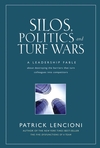|
|
LenSilo 07-06-054 Silos,
Politics and Turf Wars A
Leadership Fable Patrick Lencioni |
|
Lencioni is a consultant to senior executives and the author of several books including, The Five Dysfunctions of a Team. His works are written in the form of fables and they are popular because of the solid leadership content, but also because he weaves a good story. In this story an inspiring young consultant helps organization leaders overcome internal politics and territoriality through the concept of a "thematic goal." The new consultant was able to quickly obtain new business because of "the three Rs: his reputation, the relationships he had with executives, and the rapport he developed during sales calls." (21) To discover how to orient his practice, he "did what he would advise any other business person to do. He asked his customers what they wanted. What really kept them up at night? What made them mad? What made them want to quit sometimes? What they would give their left leg to change?" (41) After noticing wonderful cooperation in a hospital emergency room, the consultant noted that organizations often rose above inter-departmental bickering in a crisis. But why wait for a crisis, he asked? Why not identify the most important change or improvement the organization must make in the short term, say 3 to 12 months? To help the first organization overcome territorial perspective, he asked the leadership team: "What is the single most important accomplishment that this team needs to make in the next six or nine months?" (142) Once this "thematic goal" is identified, it becomes the core topic of every weekly staff meeting. The key building blocks required to make it happen are the subject areas. (151) "I strongly believe that building a cohesive leadership team is the first critical step that an organization must take if it is to have the best chance at success." "Silos are nothing more than the barriers that exist between departments within an organization, causing people who are supposed to be on the same team to work against one another. ….it is one of the most frustrating aspects of life in any sizable organization." (175) "In most situations, silos rise up not because of what executives are doing purposefully but rather because of what they are failing to do: provide themselves and their employees with a compelling context for working together." (176) "…as employees notice their colleagues in other divisions repeatedly moving in different directions, they begin to wonder why they aren't on board." (176) "If there is a place where the blame for silos and politics belongs, it is at the top of an organization." "…they must establish, for the executive team as well as the rest of the organization, a rallying cry. A thematic goal." (177) The model is this: · A thematic goal · A set of defining objectives (to meet that goal) · A set of ongoing standard operating objectives (for the regular business of the organization) · Metrics Thematic Goal: "Definition: a single, qualitative focus that is shared by the entire leadership team--and ultimately, by the entire organization--and that applies for only a specified time period." (178) This tool aligns employees and helps reset directions when things are out of focus. A thematic goal is not a vision or a BHAG but somewhere in between. It is more tangible. It is not quantitative but a description of an end result. (179) It is the current top priority, what is most important for the whole organization. (180) Defining objectives are the building blocks of what it will take to make the goal. They too are qualitative and are shared across the whole team. (182) When teams first begin to think their way to the thematic goal, some of their first suggestions will actually be building blocks to the goal. (187) The thematic goal is often very simple. (188) The place for review and planning is the regular weekly executive staff meetings. (197) Each defining objective is graded and those not doing well become the primary areas of focus of the meeting. (198) When one thematic goal is accomplished, another is developed. (202) Thematic goals tie everything together. (204) |
|
* * * * * *
